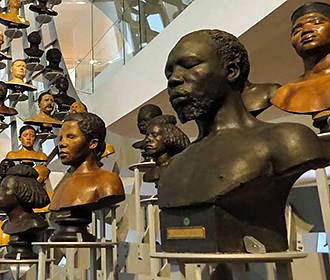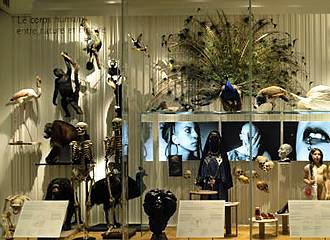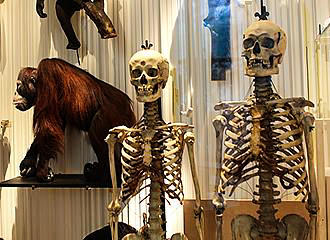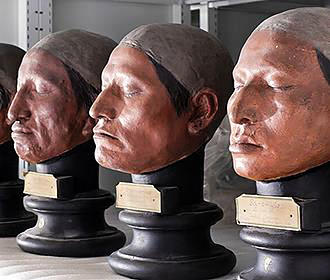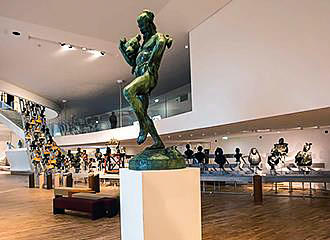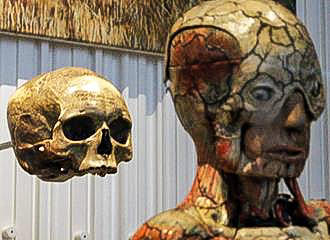Paris Musee de l’Homme museum of mankind
The Musee de l’Homme basically translates to the Museum of Mankind, and is a unique museum in Paris devoted to the natural and cultural history of man through evolution and the human adventure, plus the collections held within it are among the first in the world in this field of science and exploration.
Paris Musee de l’Homme museum of mankind history
Originally in the late 1700s, Paris started to see more of an interest in human anatomy and anthropology at the Musee d’Histoire Naturelle, especially with the explorations that had started to be conducted all over the world.
Then later on in 1800 there was a society set up called La Societe des Observateurs de l’Homme, which was designed to bring together knowledge from the museum of natural history, the school of medicine and many other different institutions along with the field of anthropology.
And eventually, by 1878 a physician and anthropologist by the name of Ernest Theodore Hamy, presented a collection from Africa, the Pacific, America, etc which was established within the Palais de l’Industrie des Champs-Elysees, the same year as the World Fair or Universal Exposition that was being held in Paris.
In 1879, due to the success of this short exhibition that only lasted six weeks, a museum was created within the Palais du Trocadero that had been built for the World Fair the year before, called the Musee d’Ethnographie du Trocadero.
The Musee d’Ethnographie du Trocadero eventually opened its doors to the public in the April of 1882 and was to provide insight into evolution of man from prehistoric times through to the rural French man of the day, basing the collection and exhibits on the conceptions of that time with the limited scientific and biological knowhow they had during the 1800s.
By 1889, which was the year when the city of Paris was again holding the Universal Exposition and the Eiffel Tower was built, the museum had evolved even more and included a display of reconstructed African villages, similar to what you would have seen at the Musee Grevin, wax works museum in Paris.
This was also a time where anthropologists could conduct studies on man from other countries around the world, such as Angola, Algeria and Madagascar, but the museum started to become more of a curiosity cabinet which meant that the fascination had started to drift.
That is until 1928 when an American anthropologist by the name of Paul Rivet became the director the Musee Ethnographie du Trocadero. His visions were to have a complete multi-disciplinary institution that would combine a university, a museum, a research laboratory and a library.
Eventually this concept became the museum come laboratory of ethnology and the Paris Musee de l’Homme museum of mankind was born in 1937, which was installed within the new Palais de Chaillot, that was the new building constructed on the same site of the original Palais du Trocadero that was destroyed prior.
The Paris Musee de l’Homme or the museum of mankind is a completely unique museum where people could discover the natural and cultural history of mankind through scientific research and discoveries.
And this museum continued up until 2008, when the Minister of Higher Education and Research, Valerie Pecresse, issued a grant for the renovation of the Musee de l’Homme Museum of Mankind, which will re-open its doors again in 2014.
About the Paris Musee de l’Homme museum of mankind
Since it was first started in 1937 by Paul Rivet, the Paris Musee de l’Homme museum of mankind is still dedicated to the human adventure with the objective showing the human presence on earth in its prehistoric dimensions, the biological, ecological, the cultural, sociological and the latest perceptions through science and technology today.
It provides information and displays on the evolution of man over the millions of years, be able to ensure people understand the diversity of humanity throughout the world, and realisation that each of us is unique.
Another part also highlights the ongoing interaction with man and nature, which also relates to climate change and how man has an impact on the world around us. But yet another area also looks at social life, the brain and behaviour, the mental and spiritual worlds, our dreams and hopes for the future along with population movements, food, climate and the realisation of the consequences of different actions that affect the planet and mankind.
In fact, the collections at the Paris Musee de l’Homme museum of mankind are amongst the first in the world in their field including fossils, a collection of flint, the first art of mankind carved in ivory and there is a complete series of around 18,000 skulls that are unique in the world and even include the skull of the philosopher Descartes.
There are also anatomical waxes on display along with a very important collection on Egyptian mummification and much, much, more to fuel the imagination and for continued study and research, just as this Paris museum was first meant to.
Facilities at Paris Musee de l’Homme museum of mankind
There are cloakrooms and toilets along with baby changing facilites, plus you may be pleased to know that since its reopening, it is also accessible to the disabled, with wheelchair loan available and a lift for access to the different levels.
In addition to a gift shop and book shop there is a snack cafateria called the Cafe Lucy open at the same time as this museum that provides hot beverages and cold drinks along with sandwiches, salads, soups and desserts, utilising seasonal and local ingredients, organic produce, AOC, AOP and Label Rouge products for freshness served with recyclable packaging or on ceramic tableware.
There is also a restaurant inside Paris Musee de l’Homme museum of mankind, called Le Cafe de l'Homme, which is accessible from the entrance to the museum and is open between noon and 2pm, that has been designed by interior designers Gilles & Boissier in an Art Deco style that can accommodate approximately 200 inside.
Yet from the grand arches this restaurant opens onto a terrace that looks over the Jardins du Trocadero and towards the famous Eiffel Tower and on a nice day this can accommodate around 100 people, plus there is also a mezzanine, which can accommodate a maximum of 12 people.
This restaurant in Paris utilises ingredients from numerous different areas and regions in France to provide meals based upon traditional French cuisine, yet with an international touch that echoes the spirit of the museum, which has influenced by cultural exchange, and you can reserve a table or even organise a private event by contacting Le Cafe de l'Homme via telephoning +33 (0) 1 44 05 30 15.
Access to Paris Musee de l’Homme museum of mankind
This Paris museum is open on a Monday and a Wednesday through to a Sunday from 10am through to 6pm, with last admission being a minimum of 45 minutes before closing time, although galleries do start to close 30 minutes prior to 6pm.
Taking people into the 21st century for a place of wonder and questions, but many of which will be answered, the cost of a ticket is €10 as of 2018 with a reduced cost of €8 for certain conditions, however, those under the age of 18 along with people who are disabled can gain free entry. But the cost is €12 to also enjoy the temporary exhibitions as well as the permanent collections.
However, the Paris Musee de l’Homme museum of mankind is also partnered with the Musee du Quai Branly, which is located only a short walk away on the opposite bank, and upon presentation of a ticket you have purchased for the Musee Quai Branly within the last 12 months, you can get a reduced cost to this museum, and the same applies the opposite way round.
Now when you wish visit the Paris Musee de l’Homme or Museum of Mankind, as we have mentioned before, it is situated within a wing of the Palais de Chaillot, which is overlooking the Jardins du Trocadero, the River Seine and over the other side to the Eiffel Tower.
It is located in the 16th Arrondissement of Paris and the nearest Metro station is located at the Place du Trocadero and called the Trocadero stop it serves the Metro lines 6 and 9.
However, there are also several buses that will get you within walking distance of the Palais de Chaillot and the museum, which include the Paris bus Lines 22, 30, 32, 63, 72 and 82, along with the Noctilien Night Bus Service via Line N53.
In addition to this, on the opposite bank you have the RER train station called the Champ de Mars - Tour Eiffel stop serving the RER C Line, plus the Batobus Water Bus that travels up and down the River Seine has a docking station by the Pont d'Iena at the foot of the Eiffel Tower.
